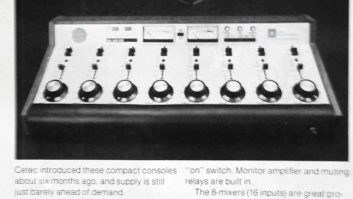WASHINGTON As the U.S. Department of Homeland Security positions itself to take the lead on public warning in this country, sources at the FCC say the commission will soon begin considering recommendations for a new public warning system to enhance or possibly replace the Emergency Alert System.
But experts contacted for this article do not expect EAS to transform quickly, which means no immediate changes are likely at the station level.
Jim Dailey, director of the Office of Homeland Security for the FCC’s Enforcement Bureau, says future policy on public warning is expected to come from the DHS, led by Secretary Tom Ridge. It’s the department that issues the color-coded terrorism threat level warnings.
A working group of the FCC’s Media Security and Reliability Council, a federal advisory group, suggested last year there should be a single federal agency overseeing EAS public warnings. Members also recommended that “research into development of alternative and/or supplemental means of communicating emergency information to the public be accelerated.”
Homeland security
“We will be working with the Department of Homeland Security examining ways to improve EAS and possibly long-term to develop a new public warning system,” Dailey said. “Public warning technology is moving very quickly, and we need to find ways to incorporate that into what we have.”
Dailey declined to identify specific warning technologies or strategies that could be used.
“Any discussion I’ve had with Department of Homeland Security people leads to a system of systems – multiple systems using multiple technologies,” he said.
Dailey said the commission is close to issuing a Notice of Inquiry, which is expected to happen this spring, possibly after the March 2 MSRC meeting.
“We are in the process of gathering as much information as possible and going through the review process before we issue any notice,” Dailey said.
Sources said the commission’s next step would be to issue a Notice of Proposed Rulemaking and seek additional comments. That could lead to eventual changes to Part 11 of the commission’s EAS rules.
“We do not know what the scope of the notice will even be yet,” Dailey said.
FCC Media Bureau Video Division Chief Barbara Kreisman said, “This is really about starting with a clean slate and designing a warning system for today, something that is not wedded to what has happened in the past. We need a digital system that utilizes the many different communication devices available today.”
Kreisman, who also is the FCC’s designated federal official to the MSRC, added that the FCC and Department of Homeland Security will speak to many people familiar with public warning.
The Partnership for Public Warning, a nonprofit organization looking at ways to improve the collection and delivery of emergency warning information, believes EAS capability needs to evolve eventually.
“There are steps that can be taken to improve EAS. Even with those improvements, EAS will still not provide the type of national warning capability the public needs,” said Ken Allen, PPW’s executive director. “We need to create a national capability that provides timely, consistent information to those who are actually at risk using multiple distribution channels.”
The Emergency Alert System was developed in 1994, its primary goal to serve the president of the United States as a means to address the nation in times of national emergency. While participation in national EAS alerts is mandatory for broadcasters, state and local EAS participation is voluntary.
EAS came under scrutiny from public warning experts following the terrorist attacks in New York and Washington in 2001. EAS was not activated by local officials in either city on Sept. 11. Most EAS experts agree that little has been done to improve the infrastructure of the current public warning system.
Critics of EAS say the system is half-finished and needs to embrace new technology to alert more people in times of emergency. They point to technology like personal digital assistants, satellite radio, cellular telephones, the Internet, and smart TVs and radios that turn themselves on when an emergency message is sent.
Reverse 911, a computer-driven telephone system that makes selective emergency notifications in predefined geographic areas, also is viewed by some as a way to supplement the current efforts of radio, television and cable broadcasters when it comes to public warning.
The ultimate goal of the EAS, according to the FCC, is “to disseminate emergency information as quickly as possible to the people who need it.”
The FCC, the National Weather Service and the Federal Emergency Management Agency fill key leadership roles within EAS.
Backing away?
Some observers told Radio World there have been indications the FCC has been backing away from EAS, noting that the agency let the federal charter of the EAS National Advisory Committee expire in 2002.
Many broadcast engineers thought the NAC played a critical role as a conduit between the broadcast engineering community and FCC regulators with regards to EAS.
Richard Rudman, vice chair of the California state emergency communications committee and former EAS NAC chairman, said a system under which EAS is supervised by the Department of Homeland Security could work.
“The thrust should be that the feds must take responsibility for the overall national and local warning mission,” he said.
Rudman said if DHS takes responsibility for EAS, the first step should be a properly supported and funded national warning needs assessment, done state by state.
“Each state’s emergency management office should be used as the vehicle to reach down to the local emergency communications committees,” he said.












